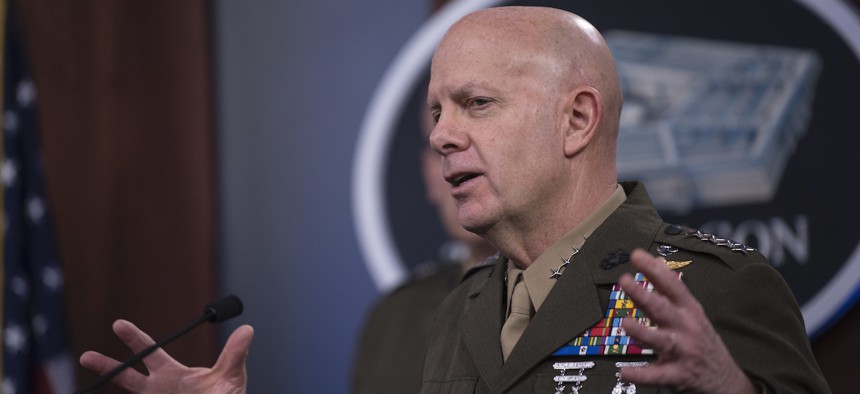
ommandant of the Marine Corps Gen. David H. Berger delivers remarks at a press briefing about the Marine Corps and COVID-19, at the Pentagon, Washington, D.C., March 26, 2020 DoD photo by Lisa Ferdinando
How the Marine Corps Plans to Become Lighter, Nimbler, More Unmanned
The Force Design 2030 report discards tanks and doubles UAV squadrons.
The U.S. Marine Corps will shrink, get rid of its tanks, add unmanned vehicles, and focus more on Asia under a force-structure plan released Wednesday.
The Force Design 2030 report calls for a Corps that has:
- 174,000 Marines, about 12,000 fewer than today.
- 18 active component fighter attack squadrons, with just 10 aircraft per squadron instead of today’s up-to-16.
- 5 active component light attack helicopter squadrons, down two.
- 21 active component infantry battalions, down three.
- Zero tanks.
The remaining infantry battalions are to be redesigned for “greater lethality and flexibility, with reduced structure (a proposed reduction per infantry battalion of approximately 200 Marines),” the report says.
But the report also calls for more long-range fires more intelligence-surveillance- reconnaissance capability, especially from drones; a new Marine Corps-specific communication network; and plenty of robots and unmanned gear. The number of UAV squadrons would double to six.
“The Marine Corps requires a family of [unmanned aerial vehicle or UAS] capabilities. We need to transition from our current UAS platforms to capabilities that can operate from ship, from shore, and able to employ both collection and lethal payloads. These future capabilities must be expeditionary and fully compatible with Navy platforms and command and control networks,” it reads.
The report mentions gaps in surveillance and reconnaissance capabilities, electronic warfare and “disruptive and less-lethal capabilities appropriate for countering malign activity by actors pursuing maritime ‘gray zone’ strategies.”
In a call with reporters, Marine Corps Commandant General David H. Berger said that his vision for the future force hinges on making the Marines more flexible, with much more versatile Marine Corps expeditionary units. These units will look less and like one another than they do today and will be more tailored for a specific operating environment.
“Some of it could be an expeditionary advanced element operating out of a base that has a function of…re-arming and refueling F-35s. It could be a function of intelligence collection, logistics, command and control. We have to experiment with all of that.. All in the mindset of, [expeditionary units] have to be capable but they also have to be able to displace, to move. We can’t make them so big and heavy that they can’t get out of their own way.”
Future gray-zone situations— in which it's hard to tell the difference between the enemy and the general population and where the enemy is using attacks that are difficult to attribute or that fall beneath the sort of violence threshold that would call for a big response—Berger said that Marines will have to remain a force that is highly forward deployed to keep advancing adversaries from “occupying every part of the house we vacate.” The Marines, he said, have to be an obstacle “denying the adversary the ability to move us out of the neighborhood. We’re reassuring the partners.”
The report also calls for a big investment in an “organic [command and control, communications and intelligence network or C4ISR] maneuver, and fires capabilities..network.. at all echelons.”
It’s an open question as to how the Marines will integrate into the giant network that is intended to link the Air Force, Army, Navy, across the air, land, and sea.
“We have a lot to learn about what joint all-domain command and control turns out to be… it’s a concept, a construct,” Berger said. “We assume, because we’re a stand-in force, we assume that we’ll always be operating within the adversaries weapons ranges. That’s where you want us...They’re going to try and degrade our networks. Those networks have to be resilient enough…Our network must be able to support us even if it's broken down into smaller elements.”
That goes beyond hardware, he said. “We develop Marine leaders with the notion that they will make decisions; they will execute in lieu of any other detailed guidance.”




